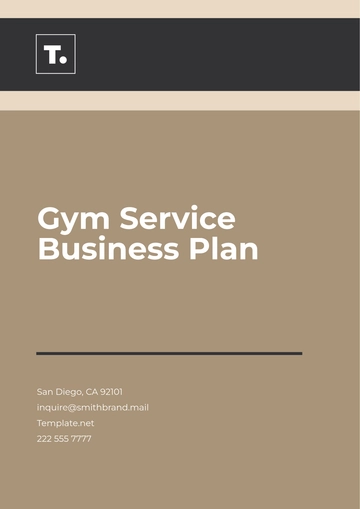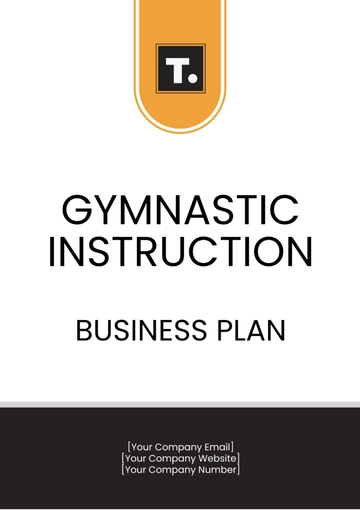Free Gym Service Business Plan

Prepared by: [Your Name]
Company: [Your Company Name]
Date: [Date]
1. Executive Summary
This business plan outlines the objectives, strategies, and financial forecasts for the proposed Gym Service Business. Our mission is to provide a high-quality fitness experience with state-of-the-art equipment, engaging classes, and personalized support to foster a community of health and wellness. By focusing on member satisfaction, personalized fitness plans, and community involvement, we aim to create a unique gym environment that helps individuals reach their fitness goals and maintain long-term health.
2. Business Objectives
Launch the gym service by the second quarter of the next fiscal year.
Achieve a membership base of 500 by the end of the first year.
Ensure high-level customer satisfaction to maintain a retention rate of 85%.
Achieve a break-even point within the first 12 months of operation.
Expand services to include additional wellness programs (e.g., massage therapy, wellness coaching) in the second year.
3. Market Analysis
3.1 Industry Overview
The global fitness industry has experienced significant growth, driven by increased awareness of health, wellness, and fitness. As the focus shifts from merely exercising to a comprehensive approach that includes mental well-being, the demand for holistic fitness services is on the rise. The trend of integrated fitness solutions, including personalized workouts, nutrition counseling, and wellness services, creates ample opportunities for innovative gym services.
3.2 Target Market
Primary Target: Young professionals aged 25-40 who are busy but committed to health and wellness. They are tech-savvy and seek personalized fitness experiences that fit into their lifestyles.
Secondary Target: Health-conscious individuals over the age of 40 looking for solutions that support healthy aging and fitness maintenance.
Tertiary Target: Youth and children seeking introductory fitness programs that promote physical activity, fun, and social engagement.
4. Competitive Analysis
Our main competitors include established gyms, boutique fitness studios, and specialized health clubs. While they offer similar services, we differentiate ourselves by:
Offering customized fitness plans tailored to individual goals and needs.
A wide variety of group fitness classes, including trending formats like HIIT, yoga, and pilates.
Incorporating community engagement activities such as group challenges and local partnerships.
Introducing flexible membership pricing that caters to various customer segments, from budget-conscious individuals to those seeking premium services.
Providing specialized programs for seniors, youth, and beginners, which is often underrepresented by competitors.
5. Service Offerings
State-of-the-art gym equipment and fitness machines for strength training, cardiovascular fitness, and functional movement.
Group fitness classes, including popular options such as yoga, pilates, cycling, Zumba, and High-Intensity Interval Training (HIIT).
Personalized training plans with one-on-one personal training sessions and expert nutrition consultations.
Wellness services, including massage therapy, injury rehabilitation, and wellness coaching (to be introduced in Year 2).
Specialized programs for seniors, focusing on mobility, balance, and low-impact exercises, as well as youth engagement programs aimed at promoting physical activity and fitness in children.
6. Marketing Strategy
6.1 Brand Promotion
Social Media Campaigns: Use platforms like Instagram, Facebook, and TikTok to showcase fitness classes, member testimonials, and special promotions.
Influencer Partnerships: Collaborate with local fitness influencers and community leaders to amplify brand visibility and attract members.
Referral Programs: Encourage existing members to refer friends and family by offering incentives such as free classes or discounts on membership renewals.
Local Partnerships: Work with nearby health-focused businesses (e.g., healthy cafes, wellness clinics) to offer joint promotions and cross-marketing opportunities.
6.2 Advertising
Paid Advertising: Invest in targeted online ads (Google Ads, Facebook, Instagram) and local print media to attract customers from the surrounding area.
Events and Open Houses: Host fitness challenges, free trials, and member appreciation days to generate buzz and increase visibility.
7. Membership Pricing
Membership Plan | Monthly Fee | Features |
|---|---|---|
Basic | $30 | Access to gym and equipment |
Standard | $50 | Includes group fitness classes |
Premium | $70 | Includes personal training sessions and nutrition consultations |
Add-Ons:
Personal training: $30 per session
Nutrition consultation: $40 per session
Massage therapy: $50 per session (launching in Year 2)
8. Operational Plan
8.1 Location and Facilities
The gym will be located in a high-traffic urban area to maximize accessibility for our target market. The facility will include:
Modern fitness equipment for strength training, cardio, and functional training.
Spacious group fitness rooms for yoga, HIIT, and cycling classes.
Wellness area for relaxation and massage therapy (to be added in Year 2).
Locker rooms with showers, secure storage, and personal amenities.
Front desk and reception area for member sign-ins, inquiries, and sales.
8.2 Staffing Requirements
Position | Number of Staff |
|---|---|
Certified Trainers | 5 |
Group Class Instructors | 3 |
Front Desk Staff | 2 |
Maintenance Personnel | 1 |
9. Financial Plan
9.1 Startup Cost Breakdown
Item | Cost |
|---|---|
Lease and Renovations | $50,000 |
Equipment | $100,000 |
Marketing and Promotion | $20,000 |
Miscellaneous | $10,000 |
Total Startup Cost | $180,000 |
9.2 Projected Income Statement (First Year)
Month | Revenue | Expenses | Net Profit |
|---|---|---|---|
January | $10,000 | $8,000 | $2,000 |
February | $12,000 | $9,000 | $3,000 |
March | $14,000 | $10,000 | $4,000 |
April | $16,000 | $12,000 | $4,000 |
May | $18,000 | $12,500 | $5,500 |
June | $20,000 | $13,000 | $7,000 |
Total | $90,000 | $64,500 | $25,500 |
Break-Even Analysis
We expect to reach the break-even point by month 10 of operation, after which the business will start generating consistent profits.
10. Risk Analysis
Key risks that could impact the success of the gym service include:
Economic downturns reduce disposable income and membership sign-ups.
Competition from local gyms or fitness trends such as online workouts.
Retention challenges if customers do not see progress or feel engaged.
To mitigate these risks, we will focus on delivering exceptional customer service, offering flexible membership options, and continuously updating our fitness offerings to stay relevant and innovative.
11. Conclusion
The Gym Service Business aims to cater to the growing demand for comprehensive fitness solutions by offering high-quality services tailored to the needs of our community. With a clear marketing strategy, a well-defined operational plan, and a focus on customer satisfaction, we are poised for success in the competitive fitness industry. By establishing a strong brand presence and delivering on our promises of personalized fitness and wellness, we will foster a loyal customer base and grow the business in the years to come.
- 100% Customizable, free editor
- Access 1 Million+ Templates, photo’s & graphics
- Download or share as a template
- Click and replace photos, graphics, text, backgrounds
- Resize, crop, AI write & more
- Access advanced editor
The Gym Service Business Plan Template from Template.net is a fully editable and customizable solution for entrepreneurs. Tailor every section to your business needs with ease, using our intuitive Ai Editor Tool. Perfect for gym owners, this template streamlines the process of creating a professional business plan to kickstart your fitness venture.
You may also like
- One Page Business Plan
- Coffee Shop Business Plan
- Restaurant Business Plan
- Food Business Plan
- Real Estate Business Plan
- Executive Summary Business Plan
- Cover Page Business Plan
- Nonprofit Business Plan
- Daycare Business Plan
- Construction Business Plan
- Startup Business Plan
- Medical Business Plan
- Bakery Business Plan
- Service Plan
- Hotel Business Plan
- Catering Business Plan
- School Business Plan
- Healthcare Business Plan
- Transportation Plan
- Sports Plan
- Car Wash Business Plan
- Salon Business Plan
- Clothing Business Plan
- Farming Business Plan
- Boutique Plan



















